
Arthurs Seat is a mountainous and small locality on the Mornington Peninsula in Melbourne, Victoria, Australia, about 85 km south east of Melbourne's Central Business District, located within the Shire of Mornington Peninsula local government area. Arthurs Seat recorded a population of 414 at the 2021 census.

Salamanca Place is a precinct of Hobart, the capital city of the Australian state of Tasmania.

The big things of Australia are large structures, some of which are novelty architecture and some sculptures. In Australia, big things have come to be seen as a uniquely Australian phenomenon, although they emerged at the same time as the so-called Roadside Giants of the United States. These structures have become affectionately known landmarks scattered throughout the country. In 2022, there were just over 1075 big things in Australia. There are big things in each state and some territories in continental Australia.

The Big Banana is a tourist attraction and amusement park in the city of Coffs Harbour, New South Wales, Australia. The grounds of the park are set amongst a banana plantation, featuring a large walk-through banana. Built in 1964, it was one of Australia's first Big Things. Other attractions include a downhill toboggan ride, ice skating rink, XD Theatre, Mini Golf, Giant Slide, Laser Tag, a water park, the World of Bananas educational experience, and escape rooms. Plantation tours are also available. On the evening of Australia Day 2014, a disused scenic lookout attraction was destroyed by fire. In keeping with the plantation theme, banana-related products are shown or sold in the park which also has a souvenir shop and restaurant. In January 2014, during the peak tourist season the Big Banana received close to 150,000 visitors. The Big Banana has been a family owned business since it was opened by Betty and John Landi, and Stella and John Enveoldson in 1964.
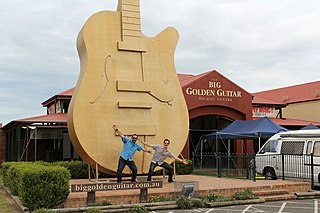
The Big Golden Guitar is one of the many "big" attractions that can be found around Australia. Located in Tamworth, New South Wales, the monument is one of the best-known points of interest in New England.
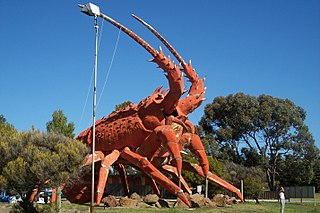
Kingston SE, formerly Kingston, is a town in the Australian state of South Australia located in the state's south-east coastline on the shores of Lacepede Bay. It is located about 240 kilometres southeast of the state capital of Adelaide and 138 kilometres north-west of the centre of the city of Mount Gambier.

Beechworth is a town located in the north-east of Victoria, Australia, famous for its major growth during the gold rush days of the mid-1850s. At the 2021 census, Beechworth had a population of 3,290.

Donnybrook is a town situated between Boyanup and Kirup on the South Western Highway, 210 kilometres (130 mi) south of Perth, Western Australia. The town is the centre of apple cultivation in Western Australia. The town is also known for its picturesque abundance of English oak trees, as well as for the Apple Fun Park, a large outdoor playground in the centre of town.

The Big Pineapple is a heritage-listed tourist attraction and big thing at Nambour Connection Road, Woombye, Sunshine Coast Region, Queensland, Australia. It was designed by Peddle Thorp and Harvey, Paul Luff, and Gary Smallcombe and Associates. It is also known as Sunshine Plantation. It was added to the Queensland Heritage Register on 6 March 2009.
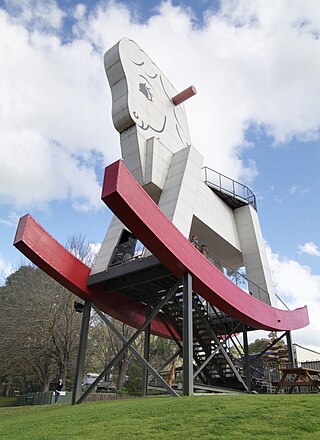
The Big Rocking Horse is a tourist attraction located in the town of Gumeracha, South Australia. Designed by David McIntosh, the structure weighs 25 tonnes, stands at over 18 metres (59 ft) tall, and is one of a number of Big Things in Australia designed to attract the attention of passing motorists. It is part of a larger complex that includes a wooden toy factory, wildlife park, and café. Owned by the Wilkinson family since the early 1970s, the complex was sold in 2004 and continues to operate today.

The Table Rock Welcome Centre is a retail and observation complex located in Niagara Falls, Ontario, Canada at the brink of the Canadian Horseshoe Falls, several hundred feet south of the former rock formation which bears its name. The complex consists of two buildings connected by an indoor pedestrian mall and anchored by "The Grand Hall", a multi-level indoor observation complex, completed in 2008.

The Kingston District Council is a local government area in the Limestone Coast, South Australia established in 1873. Kingston SE is the largest town of the district and also the seat of council.

Big Dreamers is a 55-minute documentary film showcasing the Big Things of Australia. Directed by Camille Hardman, and produced by Camille Hardman and John Fink, Big Dreamers features the construction of The Biggest Gumboot in the world in Tully, in far North Queensland.

The Big Orange is one of a number of Big Things to be found in Australia and is located near the Riverland town of Berri in South Australia. Standing at 15 metres in height, with a diameter of 12 metres, it is the biggest of the "big fruit" in Australia, and formerly incorporated a cafe, souvenir shop, function room, lookout and a 360 degree mural within the structure. Opened in 1980, in its later years the landmark has struggled to find commercial success; after changing hands in 2002, 2006 and again in 2008, it has remained closed since 2004 and abandoned since 2012. Nevertheless, it has been described as the "most defining icon of the region".
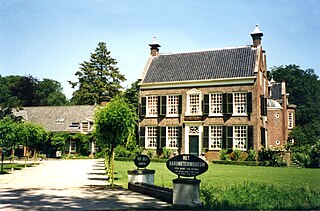
The Bert Bolle Barometer is a large water barometer. At over 12.5 metres tall, it is recognized as the largest barometer in the world by The International Guinness Book of Records. The instrument was created in 1985 in the Netherlands; in 2007 it was reinstalled in the new Visitor Centre of Denmark, Western Australia and was removed from there in 2011.
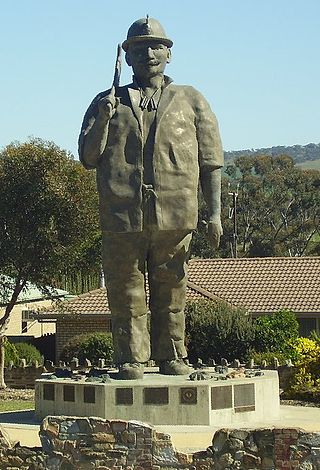
Map the Miner, also known as Map Kernow or the Son of Cornwall, is a 7-metre (23 ft) statue commemorating the Cornish mining history of the town of Kapunda in South Australia. Built by Ben van Zetten, the statue stands to at the southern entrance to the town, and is regarded as one of Australia's Big Things. The statue was destroyed by fire in 2006, but it was rebuilt and rededicated 12 months later.

The Big Trout is a 10-metre-high fibreglass model in Adaminaby, New South Wales, Australia, a popular fishing spot for trout. Built in 1973 by local artist and fisherman, Andy Lomnici, the Big Trout is part of more than 150 Big Things located throughout Australia. Originally conceived by Leigh Stewart, the Snowy Mountains Authority assisted with funding, and work on the trout started in 1971.
Larry the Lobster was the subject of an Eddie Murphy sketch on Saturday Night Live. It may also refer to:

The World's Largest Lobster is a concrete and reinforced steel sculpture in Shediac, New Brunswick, Canada sculpted by Canadian artist Winston Bronnum. Despite being known by its name The World's Largest Lobster, it is not actually the largest lobster sculpture.

Margaret Brock Reef is a reef in the Australian state of South Australia located in the state's coastal waters on its south-east coast about 7 kilometres (4.3 mi) west of the headland of Cape Jaffa and about 27.2 kilometres (16.9 mi) south-west of the town of Kingston SE. It is the site of both a navigation aid which operated as a staffed lighthouse from 1872 to 1973 and as an automatic beacon onward to the present day, and a rock lobster sanctuary declared under state law in 1973. It is named after the barque Margaret Brock which was wrecked there in 1852.




















